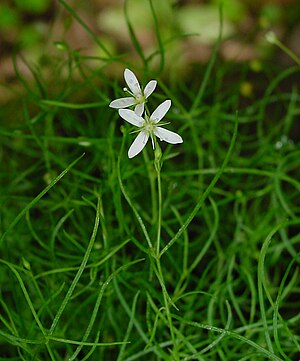Moss chickweed
| Moss chickweed | ||||||||||||
|---|---|---|---|---|---|---|---|---|---|---|---|---|

Moss-umbilical chickweed ( Moehringia muscosa ) |
||||||||||||
| Systematics | ||||||||||||
|
||||||||||||
| Scientific name | ||||||||||||
| Moehringia muscosa | ||||||||||||
| L. |
The moss sandwort ( Moehringia muscosa ), also called moss Minimize, is one of the few plants from the family of the Pink family (Caryophyllaceae) with fourfold flowers. The specific epithet muscosa is derived from the Latin word muscus (moss) and refers to the moss-like habit of the plant.
description
Moss umbilical chickweed are persistent , lively green plants and reach heights of 5 to 20 centimeters. They form loose lawns. Their stem is thin and ramified. The leaves are narrow, linear, 0.5 to 1.2 mm wide, 1 to 3 cm long and have a short spiked tip. The white flowers are always four-fold and stand in loose, few-flowered cymes. The chickweed has four 2.5 to 3.5 mm long, skin-edged, pointed sepals. The oblong, egg-shaped, entire petals are about one and a half times as long as the sepals. The plant has eight stamens and three styles. The round, kidney-shaped seed is 1.2 to 1.5 mm long with a white, approximately 1 mm wide appendage ("Caruncula", Elaiosom ). The flowering period extends from May to September.
The number of chromosomes is 2n = 24.
Occasionally there are hybrids of Moehringia ciliata × Moehringia muscosa and Moehringia bavarica × Moehringia muscosa , about half of which have flowers with four and five petals.
ecology
Like all other umbilical chickweed , the moss chickweed is a myrmecochore , i. H. their seeds are spread by ants. The white appendages ( Elaiosomata , Curunculae) of the seeds serve as food for the ants. The curuncula contains large fat, sugar and protein-containing food cells for the ants. Inwardly, oxalate glands prevent the seeds, which are not protected by a hard seed coat at this point, from further penetration by the ants.
Occurrence
The limestone plant prefers moist, shaded rocks and rock debris as a location, from the montane to the subalpine altitude. It is a Cystopteridion association character, but also occurs in societies of the order Thlaspietalia rotundifolii.
The general distribution area includes the mountains of Spain, France, Italy (to Sicily), the Alps, Jura, Carpathians to the north-western Balkans. The moss umbilical chickweed is common in the northern and southern Limestone Alps, but only scattered in the central Alps. In the Black Forest, the chickweed is only found in the Wutach Gorge - it is on the Baden-Württemberg Red List. In Austria it is absent in Vienna and Burgenland .
Taxonomy
The scientific name Moehringia muscosa was first published in 1753 by Carl von Linné in Species Plantarum .
swell
literature
- Manfred A. Fischer, Karl Oswald, Wolfgang Adler: Excursion flora for Austria, Liechtenstein and South Tyrol . 3rd, improved edition. Province of Upper Austria, Biology Center of the Upper Austrian State Museums, Linz 2008, ISBN 978-3-85474-187-9 , p. 320 .
- Hans-Christian Friedrich: Moehringia. In: Karl Heinz Rechinger (Hrsg.): Illustrated flora of Central Europe. Pteridophyta, Spermatophyta . Founded by Gustav Hegi. 2nd, completely revised edition. Volume III. Part 2: Angiospermae: Dicotyledones 1 (Phytolaccaceae - Portulacaceae) . Paul Parey, Berlin / Hamburg 1979, ISBN 3-489-60020-7 , pp. 869–870 (published in deliveries 1959–1979).
Individual evidence
- ^ G. Halliday, SN Hind: Moehringia . In: TG Tutin, NA Burges, AO Chater, JR Edmondson, VH Heywood, DM Moore, DH Valentine, SM Walters, DA Webb (eds.): Flora Europaea . 2nd, revised edition. Volume 1: Psilotaceae to Platanaceae . Cambridge University Press, Cambridge / New York / Melbourne 1993, ISBN 0-521-41007-X , pp. 151 (English, limited preview in Google Book search).
- ^ Hans-Christian Friedrich: Moehringia. In: Karl Heinz Rechinger (Hrsg.): Illustrated flora of Central Europe. Pteridophyta, Spermatophyta . Founded by Gustav Hegi. 2nd, completely revised edition. Volume III. Part 2: Angiospermae: Dicotyledones 1 (Phytolaccaceae - Portulacaceae) . Paul Parey, Berlin / Hamburg 1979, ISBN 3-489-60020-7 , pp. 856–857 (published in deliveries 1959–1979).
- ^ Erich Oberdorfer : Plant-sociological excursion flora for Germany and neighboring areas . 8th edition. Verlag Eugen Ulmer, Stuttgart 2001, ISBN 3-8001-3131-5 . Page 385–386.
- ↑ Carl von Linné: Species Plantarum. Volume 1, Lars Salvius, Stockholm 1753, p. 359 ( digitized version ).
Web links
- Moss chickweed. In: FloraWeb.de.
- Distribution map for Germany. In: Floraweb .
- Moehringia muscosa L. In: Info Flora , the national data and information center for Swiss flora .
- Thomas Meyer: Umbilical data sheet with identification key and photos at Flora-de: Flora von Deutschland (old name of the website: Flowers in Swabia )
